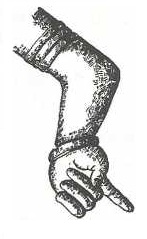Sucihasta
From Hindupedia, the Hindu Encyclopedia
By Swami Harshananda
Sucihasta literally means ‘needle pose of hand’.
This is one of the hand-poses shown in the images of gods and goddesses. It is a gesture of the right hand, in which the forefinger is held upright and all the other fingers are pressed against the palm. It signifies several things such as threat, warning, beating of drum, truth or the numbers one and hundred. The pose is also called sucīmukha-hasta.
References[edit]
- The Concise Encyclopedia of Hinduism, Swami Harshananda, Ram Krishna Math, Bangalore

